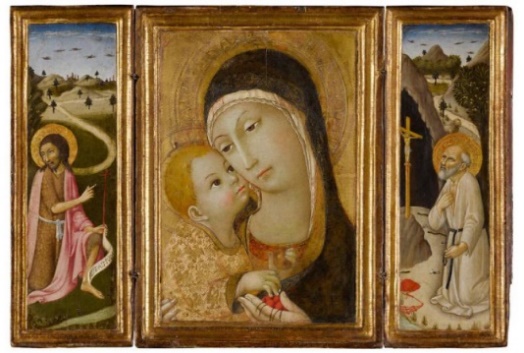Any piece of artwork symbolizes an artist’s main ideas towards specific topics. Interpreting the form and the content of any iconic work is crucial for identifying the information the painters intended to communicate to the larger audience. In “Madonna and Child,” the author Sano di Pietro presents the images of holy figures to explain their sanctity to the viewer and convey the artistic styles from earlier periods. In this visual analysis, the artistic form of “Madonna and Child” will be investigated, and the author’s ideas will be discussed.
Each painting is closely related to the age that it has been produced in. As such, “Madonna and Child” with the saints John the Baptist and Jerome was created between 1450 and 1455. Sano di Pietro is believed to have painted the triptych in Siena, Italy. In this artwork, Child Jesus and Mary, his mother, are looking at each other with an evident passion, flanked by the holy figures of the martyrs John and Jerome. This painting’s format is an extra-large triptych, possibly chosen to create a distinctive appearance and present the characters in detail. The image is made from impressive materials, such as tempera and oil paints, and engraved on wood. Additionally, the decorations are inscribed on a steel stamp material to emphasize its importance as a religious icon.
In the “Madonna and Child,” various unique color palettes can be distinguished. For instance, at first glance, Mary is dressed in a long blue gown with a yellow inner lining. However, the gown also incorporates multiple colors, such as red and white pigments, to create aesthetic beauty. The image further shows a striking color intensity and contrast, as the blue, yellow, and red colors are combined to devise varied clothing. The artist implements transparent white glazes to present a natural scene as an integral element of the characters’ holiness. At the same time, the color intensity distinguishes the foreground and the background of the painting.
The artwork further adopts unique artistic composition. For example, the “Madonna and Child” altarpiece is fabricated from a three-dimensional shape and a two-layering technique representing luxury, contemporary for that age. The use of exotic silk in decorating the painting depicts its affluence. The canopy is made from high-quality colors painted on a wooden panel, an essential part of creating religious scenes.
The iconic image also uses linear embellishments to originate a sense of volume and space. The lines adopted in this artwork create a remarkable work, which attracts the audience’s attention. For instance, the strokes show meaningful ideas at a closer view while portraying a skewed image at a distanced look. Such artistic styles aim to create a unique iconic appearance, causing the viewers to interpret the painting as a representation of the characters’ sanctity and holiness.
Sano di Pietro masterfully utilizes various visual techniques in order to present his vision of the holy figures. The magnificence of love between Madonna and Child Jesus is achieved through their poses, the passionate way they gaze at each other. This particular way of depicting saints resembles the artist’s intention to convey the iconic Byzantine style, Glykophilousa. Altogether, Sano di Pietro delivered an incredible masterpiece, signifying the saints’ importance and the style of earlier artistic eras.
The artwork “Madonna and Child” is a significant image in its form and content, representing the artist’s intended meaning. The painting adopts various artistic styles and unique color palettes such as blue, yellow, red, and white pigments to create both natural and holy scenes typical for religious scenes’ depictions. Finally, both Mary and Child Jesus’s postures offer the viewer an insight into the relationship between them, presenting feelings of love and affection.
